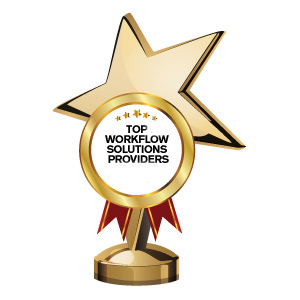THANK YOU FOR SUBSCRIBING

Top Workflow Solution Providers

Nominate a Company
Usually, the qualified subscribers of our magazine nominate companies with whom they have collaborated and experienced exceptional results to be in this list. Did a company you recently worked with give you stellar results and ROI? Did it turn out to be one you would wholeheartedly recommend to peers? Or do you know of such an outstanding company through your network? Please fill in the details below and nominate them to be featured here.
*
Thank You!

We are glad to receive your nomination. Our editorial team and evaluation panel will review your submission. Thank you for taking the time to highlight an organization driving impactful change in APAC CIOOutlook.
Data not inserted
Summit provides an AI-powered spend management platform that streamlines accounts payable and employee expense processes. Offering real-time dashboards, automated workflows, and proactive control tools, it empowers finance teams to prevent unintended expenses, improve decision-making, and drive operational efficiency, all while providing unparalleled visibility and control over financial operations.
WunderWaffen specializes in AI-driven automation, including chatbots, workflow automation, and digital employees. Unlike traditional automation, the company enhances human output by integrating people and technology for maximum productivity. Its solutions streamline operations, cut costs, and boost profits. Based in Singapore, WunderWaffen serves global clients with data-driven automation designed for growing businesses.
Huddler is a modern digital workplace platform designed to enhance collaboration, communication, and employee engagement across teams. It helps organizations build a connected, empowering work environment for employees, regardless of location, offering personalized intranet solutions for seamless collaboration.
Offshore Business Processing (OBP) offers comprehensive outsourcing services including data entry, accounting, call centers, IT solutions, and CargoWise support. Specializing in various industries such as freight forwarding, healthcare, and finance, it provides efficient, cost-effective solutions tailored to businesses' needs.
Shin-Nihon Computer Management Co., Ltd. offers a wide range of IT services including development, infrastructure construction, AI solutions, cloud services, and more. The company focuses on streamlining business operations and enhancing productivity, leveraging cutting-edge technologies like AI and cloud computing to meet customer needs.
Visual Processing Japan (VPJ) offers advanced digital transformation solutions, specializing in Digital Asset Management (DAM), Product Information Management (PIM), and Work Management (WM) through its CIERTO platform. It helps businesses to optimize media and content workflows, enhance productivity, and support multi-channel distribution.
vSaaS Global specializes in process automation, data analytics, and SaaS application development. Using the MAM model Mapping with Miro, Automating with Smartsheet, and Managing with Josys it optimizes business workflows, driving efficiency, innovation, and cost-effectiveness across industries.
Top Workflow Solution Providers
More in News
Digitalization takes retail by storm
Wednesday, July 30, 2025
With new trends such as IoT, Artificial Intelligence (AI), smart beacons, AR, and VR surfacing the tech space, the retail sector is set to be rejuvenated with more sophistication. The advent of online shopping saw a new steam of solutions and services incorporated into the digital marketing and retail industry. Machine learning algorithms allowed vendors to learn the preferences of users to cross-sell different products, thereby enhancing their marketing campaign. A user looking for mobile phone will be introduced with trending and highly rated products, allowing the user to have a comparative perspective of the available choices, benefitting not only the user but the company advertising the product as well. Another recent adaptation of digitalization is with AR & VR. Until now, the only hands-on approach to a particular product for a customer was either to visit a retail store or to see an image of the product online. Not everybody was able to visit retail stores and the product that was delivered to them never really lived up to the expectations they had with the online description and image. AR & VR allows merchants to provide users with an augmented tour of the product, allowing users to see the product in person, without having to travel to the retail stores. A similar trend is followed across real estate and marketing industries where customers can latch on to their VR headsets and experience the product first-hand before making the purchase decision. Although such innovations are fairly new and are in the beta stages of testing, they offer a promising endeavor for the retail industry, paving the way for newer job opportunities and conceptualization of the future of technology.
Finding the Right Balance in E-commerce Websites
Wednesday, July 30, 2025
Fremont, CA: Marketing teams face the challenging task of balancing the delivery of engaging content and features that modern shoppers expect while ensuring optimal web performance. If speed and reliability start to decline, it risks alienating valuable customers. The challenge intensifies as adding more content and features can lead to slower site performance, negatively impacting the shopping experience. As marketing teams continually strive to enhance content offerings, it becomes crucial to safeguard website performance. Third-party services are often a fast and easy way to add cutting-edge features and functionality to a website, negating the need for organizations to undertake any development work themselves. That being said, these elements are often the weakest links when there is high website traffic. To mitigate these risks, marketers must deploy third-party services only when needed and with adequate backup plans in place. Web page load time tends to increase according to page weight. There are many optimization techniques to keep page weights in check, especially when working with mobile sites, which have to compete with constrained networks. Marketing teams should consider using static content on landing pages, enabling the pages to load faster, while also being less problematic than dynamic content. Static landing pages also help search engine to generate better rankings by being easier to crawl and index. Another point of potential failure is third-party tagging. Tag management services are vital during peak sales periods as they can often eliminate unnecessary tags to streamline and improve website performance.
Omni-channel payments for better Customer Satisfaction
Tuesday, July 29, 2025
According to a new study by ACI Worldwide and Ovum, today's retail space, an omni-channel payment strategy is a key to the customer's experience to be as seamless as possible. Over 79 percent of merchants and retailers are willing to adopt an omni-channel approach, while 80 percent of respondents in the EMEA region agree that the technology advancements in payments will add to the benefits of their organization. 66 percent are even willing to spend more to receive a broader range of payment services conditioned upon the services adding to their business value. 89 percent of merchants and retailers say that they expect an increase in operational efficiency with the addition of new means of payment while 88 percent say that the investment has further enhanced their customers' experiences. The rapid digitization of commerce and payment technology is a critical aspect of improving customer engagement while reducing costs at the same time. The EMV payment method that used to be a pain-point for in-store retail fraud has now reduced, according to 82 percent of merchants in the U.S., however, the fraudulent activity has now shifted online. In the Asian region, however, cards continue to dominate the retail and merchant sales figures, accounting for 52 percent of payments. For retailers and merchants to remain competitive in the ever-changing market, they will need to foster stronger partnerships with payment companies that, both, understand their market and improve the omni-channel capabilities to reach new markets.
Transforming Supply Chain Management through Big Data Analytics
Tuesday, July 29, 2025
Fremont, CA: Organizations are experiencing a significant transformation in supply chain management thanks to big data. The sheer volume of data available can make it challenging for companies to identify the most relevant information for analysis and interpretation. Businesses are now thoroughly exploring their datasets, uncovering valuable insights that can enhance their operations. Big data analytics is improving the accuracy, clarity, and insightfulness of supply chain networks, facilitating a more comprehensive exchange of contextual intelligence throughout the supply chain. Integrating big data and advanced analytics into business processes helps streamline operations. The main benefit of incorporating big data analytics in supply chain management is customer service. By leveraging big data analytics, organizations can get a complete view of what their customers’ requirements are, understand their needs and preferences, and accordingly create a delightful customer experience. Another major benefit is supply chain traceability. Advances in digital technologies enable supply chain companies to precisely track products in their supply chain. Sensors along with IoT enable end-to-end traceability, which helps companies quickly identify the instances of issues. Big data analytics along with machine learning and optimization algorithms help identify patterns and associations between the datasets and assist in deducing strategic and tactical procurement decisions. Predictive analytics help organizations identify future trends and risks including supplier risk, pricing risk, and geographical risk. For organizations that deal with supply chain activities, speed and agility are the key driving factors. Big data also enables supply chain managers to maintain an optimum level of inventory so that they do not face a stock-out situation. While many organizations still haven’t adopted big data, incorporating it will serve as the catalyst that improves efficiency, productivity and gets them moving on their journey. See Also: Top Big Data Solution Companies See Also: Top Data Analytics Companies In Europe
Blockchain to Revolutionize Supply Chain
Monday, July 28, 2025
Supply chains have transformed how they work; now supply chains are being transformed. The name of the new diversion is blockchain. Supply chains need transparency and traceability; blockchain is great at these two things. The transaction-based systems are designed on a distributed blockchain ledger and can confirm the exchange of goods as transactions. This straightforwardness can guarantee the cost of goods and precisely reflect the original cost of manufacturing them eliminating the difficulties in constrained work and unlawful sourcing of materials. Blockchain can disrupt numerous enterprises. Early adoption of blockchain will advance in the coming three to seven years; however, standard adoption in the supply chain industry and at scale is likely at least ten years away. Like RFID in its initial days, business procedures and norms must be settled before blockchain can achieve its potential. Many trusts that blockchain is a substitution for conventional database advancements — it does not have the capacity to create, read, refresh, and erase data. With the assistance of blockchain, database abilities will progressively scale and coordinate over a more extensive number of supply chain network accomplices and eventually clients. There are no blockchain solutions for purchase for supply chain use right now. Only associations that are particularly risk-tolerant and early adopters of technologies ought to consider supply chain management based on blockchain activities in the next two to five years. The delayed adoption or early adoption of a comprehensive supply chain and supply chain development can harm the organization. Blockchain may at present be not far off; however, its potential requires attention now.
Increasing Impact of Smart Technology on Recruitment
Monday, July 28, 2025
Fremont, CA: The landscape of recruitment and job markets is set to evolve, presenting new opportunities for both agile and innovative employers and job seekers, according to the recruiting firm Feeds. The transformation includes the utilization of data science analysis to pinpoint the most suitable candidates, the virtualization of the screening process, and the rising demand for highly skilled professionals driven by digitalization technologies. The traditional 'promote and apply' model for enrollment will be replaced with another approach – 'find and connect.' The 'find' component of the model includes utilizing advanced innovation and data science analysis to gain insight into competitor pools. To hasten the short listing process Automated and machine-learning calculations will be utilized to screen CVs and speak with applicants, which are going to change the semi-organized information of CVs into predictable configurations. Soon, job seekers also could begin to grasp the innovation to feature aptitudes and capabilities and upgrade their online profiles and portfolios Job seekers are going to implement video content on their LinkedIn profiles to enhance their profile visibility. This will provide contracting supervisors with a profound understanding of their skills. Given the present rate of change, information and abilities have a shorter timeframe of practical usability. So, search for positions that offer upskilling and improvement. It will spark interest in back innovation specialists who can drive a bank's innovation strategy.
I agree We use cookies on this website to enhance your user experience. By clicking any link on this page you are giving your consent for us to set cookies. More info



























